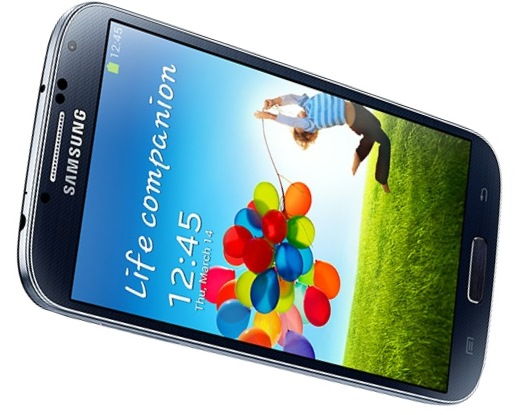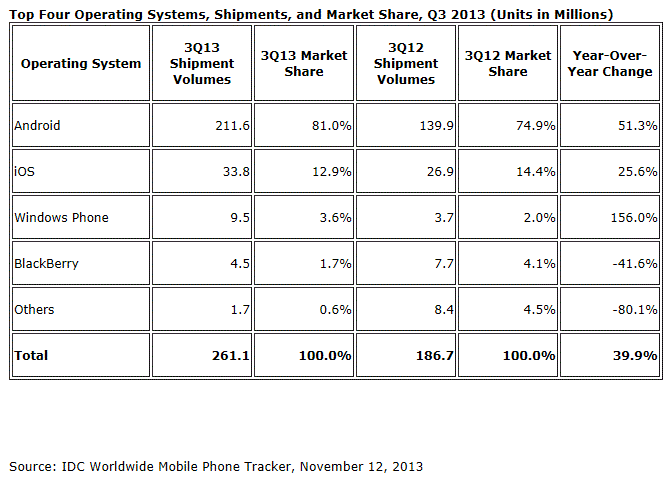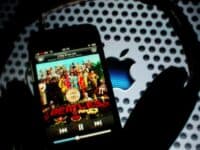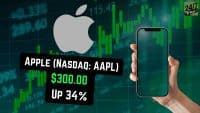Apple Inc. (NASDAQ: AAPL) has enjoyed a huge success with the iPhone variations to date. Apple still has the world’s most valuable company status, but there is a problem rising against it. Google Inc. (NASDAQ: GOOG) keeps grabbing more market share with cheaper Android smartphones. It also now seems as though Microsoft Corp. (NASDAQ: MSFT) is getting more recognition and adoption of its Windows smartphones than almost anyone would have guessed. As you might have guessed, though, BlackBerry Ltd. (NASDAQ: BBRY) is seeing its market share dwindle, on its way to what may be zero.
International Data Corporation (IDC) is signaling that Android has moved above 80% market share for the first time in its history. Also, Windows smartphone shipments in the third quarter soared by some 156% from a year ago. The total smartphone space grew by 39.9% from the third quarter of 2012, so this means that Google has taken even more of the market share while the overall market has expanded.
IDC’s Worldwide Quarterly Mobile Phone Tracker report showed a total base of 211.6 million smartphone units shipped during the third quarter of 2013. Android’s total share was 81% of that entire base.
Apple did release its iPhone 5 upgrades, but the bulk of that effort will not be seen until the fourth quarter figures are out. Before you consider Apple dead, IDC did specify that iOS stands to reap another record quarter in terms of volumes, market share and year-over-year growth based on the shipment strength at the very end of the quarter.
Surprise, surprise. Microsoft’s Windows phone’s 156% shipment growth was off of a very small base of 3.7 million units a year ago, and its market share is still less than 5%. IDC indicates that Nokia’s support in the effort has helped drive the platform into multiple tiers and price points. We would also point out that if the total market grew by almost 40%, and Windows grew by more than 150%, that is almost four-times the relative strength of the market.
IDC points out the one important factor behind the success of Android and Windows, and that is the price. Both platforms have multiple devices at prices low enough to be affordable to the mass market. IDC says that this mass market is the growth driver, and that should only make sense, if you think about it.
Smartphone average selling prices were down by 12.5% in the third quarter at an average of $317. Large-screen devices (phablets) also come with a higher selling price than smaller screen devices, and their market average was $443 in the quarter (down by 22.8% from the $573 phablet average selling price a year ago).
Samsung accounted for 39.9% of all Android shipments. Apple’s iOS did manage to show total volume gains, and it reached new record third-quarter volumes. Its market share decline was likely due to soft demand in the weeks leading up to the launch of iOS 7 smartphones.
Nokia Corp. (NYSE: NOK) accounted for 93.2% of all the Windows Phone-powered smartphones shipped during the quarter. BlackBerry Ltd. (NASDAQ: BBRY) saw the largest decline, based on softer demand for its new BB10 operating system and continued demand for its older BB7 within emerging markets. IDC points out the consequences of a new CEO and a $1 billion infusion remains to be seen.
The table below should sum up the gains and losses rather easily.
Are You Ahead, or Behind on Retirement? (sponsor)
If you’re one of the over 4 Million Americans set to retire this year, you may want to pay attention.
Finding a financial advisor who puts your interest first can be the difference between a rich retirement and barely getting by, and today it’s easier than ever. SmartAsset’s free tool matches you with up to three fiduciary financial advisors that serve your area in minutes. Each advisor has been carefully vetted, and must act in your best interests. Start your search now.
Don’t waste another minute; get started right here and help your retirement dreams become a retirement reality.
Thank you for reading! Have some feedback for us?
Contact the 24/7 Wall St. editorial team.





